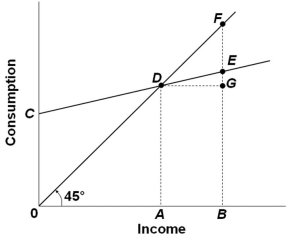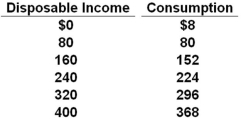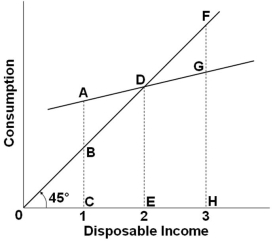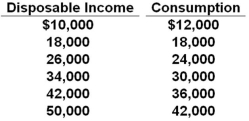A) The average price in the economy
B) Consumer spending
C) Personal saving
D) The real interest rate
Correct Answer

verified
Correct Answer
verified
Multiple Choice
The saving schedule shows the relationship of saving of households to the level of:
A) Consumption
B) Investment
C) Disposable income
D) The average propensity to save
Correct Answer

verified
Correct Answer
verified
Multiple Choice
The Great Recession of 2007-2009 altered the prior behavior of consumers in the economy by:
A) Shifting the consumption schedule up
B) Shifting the consumption schedule down
C) Shifting the saving schedule down
D) Moving the economy down along a stable consumption schedule
Correct Answer

verified
Correct Answer
verified
Multiple Choice
If households consume less at each level of disposable income, they are:
A) Saving more
B) Saving less
C) Spending more
D) Working less
Correct Answer

verified
Correct Answer
verified
Multiple Choice
An increase in disposable income:
A) Increases consumption because it shifts the consumption schedule upward
B) Decreases consumption because it shifts the consumption schedule downward
C) Increases consumption by moving upward along a given consumption schedule
D) Decreases consumption by moving downward along a given consumption schedule
Correct Answer

verified
Correct Answer
verified
Multiple Choice
 Refer to the consumption schedule above. The marginal propensity to consume is represented by:
Refer to the consumption schedule above. The marginal propensity to consume is represented by:
A) GF/BE
B) EF/BE
C) GE/AB
D) DE/AB
Correct Answer

verified
Correct Answer
verified
Multiple Choice
Given the expected rate of return on all possible investment opportunities in the economy, a(n) :
A) Increase in the real rate of interest will tend to increase the level of investment
B) Decrease in the real rate of interest will tend to increase the level of investment
C) Decrease in the real rate of interest will tend to decrease the level of investment
D) Change in the real interest rate will have no impact on the level of investment
Correct Answer

verified
Correct Answer
verified
Multiple Choice
The nominal rate of interest is 8.5 percent and the real rate is 5 percent. The expected rate of return on an investment is 8 percent. The firm should:
A) Not undertake the investment because the expected rate of return of 8 percent is less than the nominal interest rate
B) Not undertake the investment because the expected rate of return of 8 percent is less than the nominal plus the real interest rate
C) Undertake the investment because the expected rate of return of 8 percent is greater than the difference between the nominal and real interest rates
D) Undertake the investment because the expected rate of return of 8 percent is greater than the real rate of interest
Correct Answer

verified
Correct Answer
verified
True/False
Saving equals disposable income plus consumption.
Correct Answer

verified
Correct Answer
verified
Multiple Choice
The disposable income (DI) and consumption (C) schedules are for a private, closed economy. All figures are in billions of dollars.  Refer to the data above. If consumption increases by $10 billion at each level of disposable income, the marginal propensity to consume will:
Refer to the data above. If consumption increases by $10 billion at each level of disposable income, the marginal propensity to consume will:
A) Change, but the average propensity to consume will not change
B) Change, and the average propensity to consume will change
C) Not change, but the average propensity to consume will change
D) Not change, and the average propensity to consume will not change
Correct Answer

verified
Correct Answer
verified
Multiple Choice
Dissaving occurs when:
A) Income is greater than saving
B) Income is less than consumption
C) Saving is greater than consumption
D) Saving is greater than the interest rate
Correct Answer

verified
Correct Answer
verified
Multiple Choice
Art Buchwald's article in the Last Word section of the chapter, "Squaring the Economic Circle," is a humorous description of:
A) The multiplier effect
B) A recessionary gap
C) An inflationary gap
D) The marginal propensity to save
Correct Answer

verified
Correct Answer
verified
Multiple Choice
Assume that MPS is 0.4. If spending increases by $8 billion, then real GDP will increase by:
A) $8 billion
B) $13.3 billion
C) $15 billion
D) $20 billion
Correct Answer

verified
Correct Answer
verified
Multiple Choice
A firm invests in a new machine that costs $5,000 a year but which is expected to produce an increase in total revenue of $5,200 a year. The current real rate of interest is 7 percent. The firm should:
A) Undertake the investment because the expected rate of return of 10 percent is greater than the real rate of interest
B) Undertake the investment because the expected rate of return of 8 percent is greater than the real rate of interest
C) Not undertake the investment because the expected rate of return of 6 percent is less than the real rate of interest
D) Not undertake the investment because the expected rate of return of 4 percent is less than the real rate of interest
Correct Answer

verified
Correct Answer
verified
Multiple Choice
 Refer to the saving schedule above. The break-even income would be level:
Refer to the saving schedule above. The break-even income would be level:
A) 0
B) 1
C) 2
D) 3
Correct Answer

verified
Correct Answer
verified
Multiple Choice
Which of the following would shift the consumption schedule downward?
A) A decrease in real interest rates
B) An increase in the value of financial assets
C) An increase in the probability of a recession
D) A decrease in disposable income
Correct Answer

verified
Correct Answer
verified
Multiple Choice
The so-called Paradox of Thrift that became quite obvious in the Great Recession of 2007-2009 refers to all of the following, except:
A) Saving may be virtuous for the individual, but it could be bad for the economy as a whole
B) Consumers becoming thriftier may help long-term growth, but ironically reduces current output
C) In trying to spend less now, consumers will end up spending more later on
D) As individuals try to save more, the whole group may end up saving less as total income declines
Correct Answer

verified
Correct Answer
verified
Multiple Choice
The so-called wealth effect will result in households:
A) Spending more and saving less
B) Spending less and saving more
C) Spending less and saving less
D) Spending more and saving more
Correct Answer

verified
Correct Answer
verified
Multiple Choice
 Refer to the consumption schedule above. As income falls from level 3 to level 2, the amount of:
Refer to the consumption schedule above. As income falls from level 3 to level 2, the amount of:
A) Consumption increases and the amount of dissaving increases
B) Consumption decreases and the amount of dissaving decreases
C) Consumption decreases and the amount of saving decreases
D) Consumption decreases and the amount of saving increases
Correct Answer

verified
Correct Answer
verified
Multiple Choice
 Refer to the consumption schedule above. The marginal propensity to consume is:
Refer to the consumption schedule above. The marginal propensity to consume is:
A) .60
B) .75
C) .80
D) .20
Correct Answer

verified
Correct Answer
verified
Showing 101 - 120 of 142
Related Exams